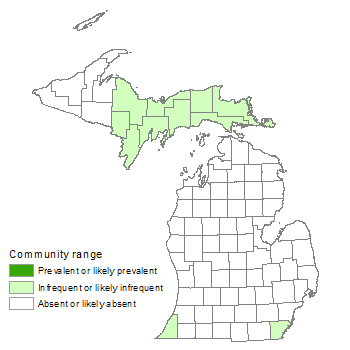Cave
Overview
A cave is defined as a cavity beneath the earth’s surface, often with an opening to the surface, characterized by little or no light, no primary producers, and biotic communities of one or two trophic levels that import energy from outside the system. Caves are known from the eastern Upper Peninsula, and historically, from southeast Lower Michigan.
Rank
Global Rank: G4? - Apparently secure (inexact)
State Rank: S1 - Critically imperiled

Landscape Context
All of Michigan’s caves occur in karst landscapes, where dissolution of limestone or dolomite creates an underground drainage system that can include caves. Michigan’s areas of true karst are limited in extent, but include considerable variety. The Michigan Karst Conservancy owns the 480 acre Fiborn Karst Preserve in Michigan's Upper Peninsula, which includes an extensive and nearly complete karst drainage system with sinkholes, caves, and disappearing streams.
Soils
There is no information on soil development within Michigan’s caves, but since they are derived from limestone or dolomite, soils are likely mildly to moderately alkaline.
Natural Processes
Caves form from the dissolution of limestone, dolomite, or gypsum. The dissolution of the bedrock, often along faults or cracks in the bedrock, results in the creation of an underground drainage system rather than typical surface streams. Some caves collapse, forming sinkholes.
Vegetation
It is assumed that there is no vegetation within Michigan’s caves.
For information about plant species, visit the Michigan Flora website.
Plant Lists
It is assumed that there is no vegetation within Michigan’s caves.
Noteworthy Animals
Caves provide habitat and hibernacula for bats. A small cave in Monroe County, now destroyed, was rumored to have a population of blind crayfish. Little is known about the biology of Michigan's remaining caves, but contrary to the situation in better-known caves of other states, no evidence exists that unusual organisms or groupings of organisms make their homes in them.
Rare Plants
None documented.
Rare Animals
None documented.
Biodiversity Management Considerations
In the Upper Peninsula, one large and several small caves have been quarried away. Small caves in Monroe County have also been destroyed. Erosion damage can occur due to uncontrolled foot traffic. Maintaining a forested buffer around caves will help prevent soil erosion and associated runoff into caves.
Variation
Caves form from the dissolution of several rock types including limestone, dolomite, and gypsum, which differ in their chemical composition and rates of erosion, and influence cave size and structure.
Similar Natural Communities
Places to Visit
- Hendrie River Water Cave, Sault Sainte Marie State Forest Management Unit and Michigan Karst Conservancy, Mackinac Co.
- Kochab Cave, Sault Sainte Marie State Forest Management Unit and Michigan Karst Conservancy, Mackinac Co.
- Quarry Cave, Michigan Karst Conservancy, Mackinac Co.
Please note that Michigan Karst Conservancy preserves are open to the public. However, written permission and appropriate equipment are required for entry into the caves.
Relevant Literature
- Dorr, J.A., Jr., and D.F. Eschman. 1970. Geology of Michigan. University of Michigan Press, Ann Arbor, MI. 470 pp.
- Faber-Langendoen, D., ed. 2001. Plant communities of the Midwest: Classification in an ecological context. Association for Biodiversity Information, Arlington, VA. 61 pp. + appendix (705 pp.).
- Michigan Karst Conservancy. http://www.caves.org/conservancy/mkc/michigan_karst_conservancy.htm.
Citation
Cohen, J.G., M.A. Kost, B.S. Slaughter, D.A. Albert, J.M. Lincoln, A.P. Kortenhoven, C.M. Wilton, H.D. Enander, and K.M. Korroch. 2020. Michigan Natural Community Classification [web application]. Michigan Natural Features Inventory, Michigan State University Extension, Lansing, Michigan. Available https://mnfi.anr.msu.edu/communities/classification. (Accessed: October 25, 2025).
Kost, M.A., D.A. Albert, J.G. Cohen, B.S. Slaughter, R.K. Schillo, C.R. Weber, and K.A. Chapman. 2007. Natural Communities of Michigan: Classification and Description. Michigan Natural Features Inventory, Report No. 2007-21, Lansing, MI.


